- Ramat Wildlife Society
- Phone: 254 791 197 454
- Email: [email protected]


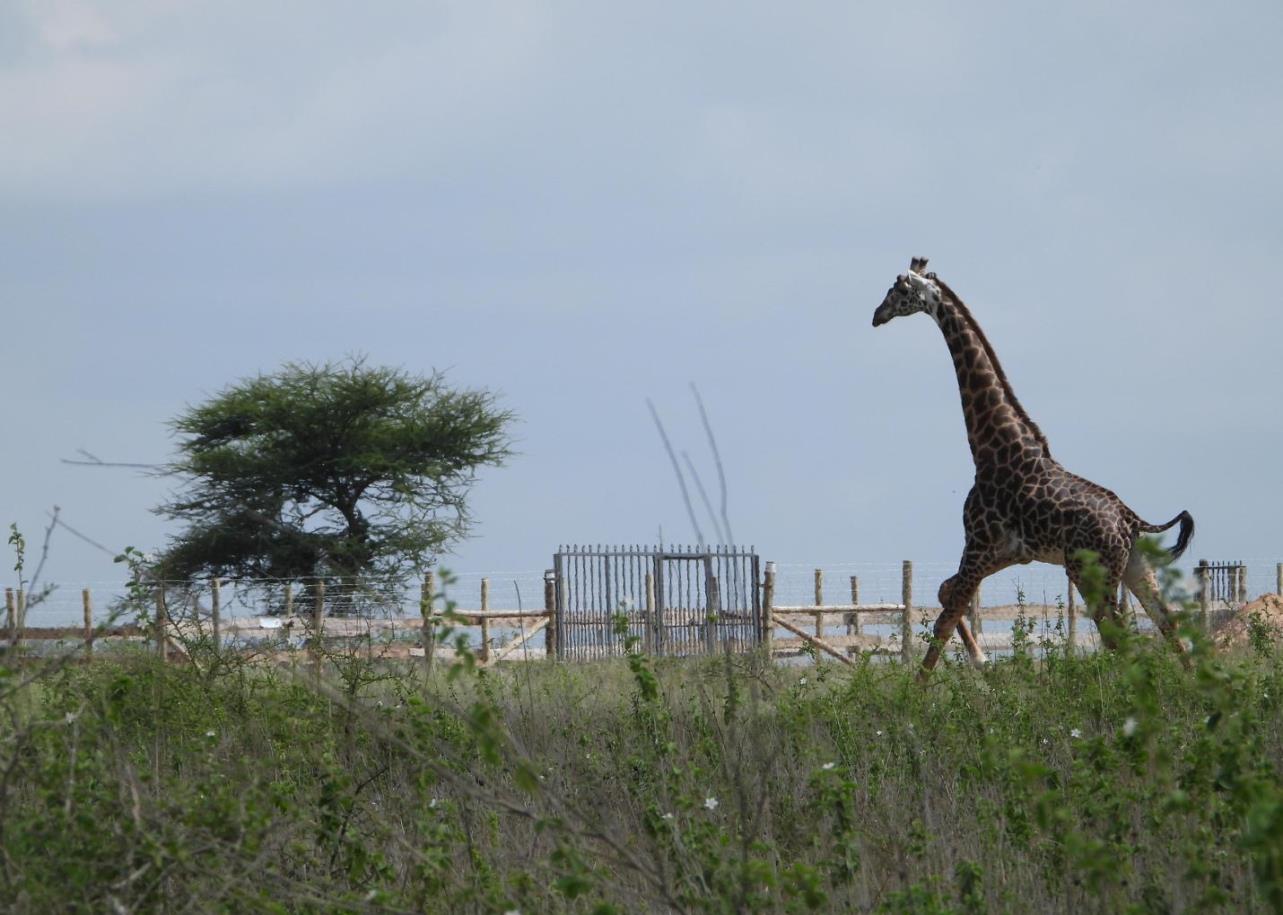
Kajiado Central, Kenya - A rapid field assessment conducted in December 2024 reveals an alarming trend of fencing impacting wildlife within conservancies in Central Kajiado. The study, led by RAMAT Wildlife Society and Kenya Wildlife Society with support from Save the Giraffe Now, investigated the effects of increasing numbers of fenced private properties on wildlife movement and access to critical habitats in Matapato North and South Wards.
The area, a vital dispersal zone between Amboseli National Park and Lake Magadi, is witnessing a surge in fencing due to land sales to external investors. This fragmentation restricts wildlife to smaller areas, leading to starvation, thirst, and increased vulnerability to poaching. The report highlights that between 2023 and 2024, over 30 giraffes and hundreds of other animals have become trapped within these fences. Tragically, 24 giraffes were killed by the fences during the same period.
Electric fences, in particular, pose a significant threat, with reports of electrocuted giraffes. Water sources, though present, are often inaccessible to wildlife trapped within fenced areas, exacerbating the crisis during drought.
The report underscores the urgent need for intervention to mitigate the spread of fencing, restore wildlife migratory routes, and foster coexistence between communities and wildlife.
17th – 24th December 2024
REPORT PREPARED BY: MAYIAN LEMAYIAN AND ROSE KINKI
Edited by: John Kisimir and Seleyian Patroip
Matapato North and South Wards, located in Central Kajiado, are strategically situated between the iconic Amboseli National Park and Lake Magadi. This region is a critical wildlife dispersal zone for the Amboseli ecosystem and an essential migratory corridor connecting southern Kenya to northern Tanzania landscapes. Communal group ranches (Mailua, Oldoinyo Orok, and Meto) in this area have been subdivided into individually owned parcels that support a dual livelihood of pastoralism and seasonal agriculture but have continued to host significant wildlife populations.
Over the past three years, local communities with the support of RAMAT Wildlife Society have established community-led conservancies as a strategic effort to engage with the wildlife-tourism economy and promote sustainable livelihoods while minimizing instances of human-wildlife conflicts. Despite these conservation efforts, the RAMAT Wildlife Society has been reporting alarming statistics regarding wildlife trapped within wired-fenced private properties, leading to starvation, thirst, and increased vulnerability to poaching. Between 2022 and 2024, over 30 giraffes and hundreds of other animals were reported to have become trapped within privately fenced spaces. In the same period, 24 giraffes were killed by these fences. Without immediate intervention, the spread of fencing could lead to a catastrophic loss of biodiversity, severely threatening the survival of the conservancies.
With support from Save the Giraffe Now, a rapid field assessment was conducted to evaluate fenced properties within the conservancies in Matapato North and South Wards. This initiative was reinforced by the invaluable collaboration of the Kenya Wildlife Service - Kajiado, which provided critical logistical support and dedicated officers in the navigation, and access to the private properties.
This initiative marks an important first step in protecting Central Kajiado's unique biodiversity and preserving its ecological and cultural heritage. With timely support, the immediate threats posed by fencing can be mitigated, restoring essential wildlife migratory routes, and fostering peaceful coexistence between wildlife and local communities.
The three-day rapid assessment by RAMAT Wildlife Society and the Kenya Wildlife Service investigated fenced properties across 11 conservancies (in Emotoroki, Mailua, Oldoinyio Orok, and Oloirimirimi locations), focusing on their potential threat to wildlife safety, effect on wildlife movement, safety, and access to critical habitats. Armed with GPS tools and data collection forms, the team collaborated with conservancy leaders, government administrators (chiefs), and community stakeholders on mapping and identifying fenced properties in the region. The exercise also examined the disruption of habitat connectivity, the restriction of traditional wildlife migration routes, and the broader implications for regional conservation initiatives. By understanding these issues, the assessment sought to inform sustainable land management practices and promote coexistence between human activities and wildlife conservation.
Olchorro Oibor Conservancy: Located in Matapato North, this 3,776-hectare conservancy was founded in April 2024 by 89 landowners committed to environmental conservation. However, widespread poverty in the area over the years has become a major driver of significant land sales by locals to external investors. The new landowners have introduced wire fencing, some with solar-powered electric components that pose risks to wildlife, livestock, and unaware locals. Giraffes were the main wildlife sighted inside the fenced spaces with one giraffe reportedly electrocuted.
A local worker in one of the properties reported to the team that 10 giraffes had died through electrocution. Despite the presence of dams and boreholes, water remains inaccessible to wildlife during drought periods. The primary activity on the property is livestock rearing. The property exhibited farming activities, but no water resources were available for wildlife.
| # | Property owner | GPS Coordinates | Height (meters) | Fence status | Acreage (Ha) | Sighted Wildlife |
|---|---|---|---|---|---|---|
| 1 | Wambugu Kariuki | -2.26875°S 36.92924°E | 2 | electric | 404 | Giraffes - 10 |
Oltepesi Conservancy: Situated in Emotoroki, Matapato North, this 2,911-hectare conservancy was established in March 2024 by 55 landowners. The conservancy has a growing fencing problem with 103 hectares of fenced private properties inside it. Farming activities were observed, and minimal wildlife sighting occurred. The property exhibited crop farming activities, but no water resources are available for wildlife.
| # | Property owner | GPS Coordinates | Height (meters) | Fence status | Acreage (ha) | Sighted Wildlife |
|---|---|---|---|---|---|---|
| 1 | Wambogo Kariuki | -2.26875°S 36.929224°E | 2 | electric | 83 | Giraffes - 1 |
| 2 | Favent Kimani | -2.24609°S 36.02775°E | 2 | Not electric | 20 | No wildlife |
| Total | 103 | |||||
Osewan Conservancy: This 7,773-hectare conservancy is community-owned and was established by 49 landowners to promote environmental conservation and modern pastoralism. A total of 221 hectares within the conservancy is fenced. No wildlife was sighted within the fenced properties - a sign of habitat restrictions for wildlife in the fenced spaces.
| # | Property owner | GPS Coordinates | Height (meters) | Fence status | Acreage (ha) | Sighted Wildlife |
|---|---|---|---|---|---|---|
| 1 | Patrick Githuka | -2.31285°S 37.03056°E | 2 | electric | 49 | No wildlife |
| 2 | Semera | -2.30036°S 37.04070°E | 2 | electric | 28 | No wildlife |
| 3 | Unknown. Previously owned by Mulolo Lemokor | -2.30544°S 37.05015°E | 2 | Electric | 12 | No wildlife |
| 4 | Charles | -2.30007°S 37.07331°E | 2 | electric | 6 | No wildlife |
| 5 | Evans Ombui | -2.32147°S 37.06294°E | 2 | electric | 57 | No wildlife |
| 6 | Joseph Ole Lenku | -2.326150°S 37.03276°E | 2 | electric | 61 | No wildlife |
| 7 | Nelson Munene | -2.34269°S 37.05138°E | 2 | electric | 8 | No wildlife |
| Total | 221 | |||||
Ilesai Conservancy: Located in Matapato South, this 6,370-hectare conservancy was formed by 37 Maasai landowners dedicated to conservation. 118 hectares are fenced, primarily for future farming activities. No wildlife sightings within the fenced spaces.
| # | Property owner | GPS Coordinates | Height (meters) | Fence status | Acreage (ha) | Sighted Wildlife |
|---|---|---|---|---|---|---|
| 1 | Unknown. Sold by Nkonere Leshoko | -2.25229°S 37.09732°E | 2 | Not electric | 61 | No wildlife |
| 2 | Alex Kiminta (manager) | -2.24382°S 37.06651°E | 2 | Power not installed | 57 | No wildlife |
| Total | 118 | |||||
Lumbwa Conservancy: Located in Matapato South, this conservancy spans approximately 4,327 hectares of which 412 hectares are fenced. It was formed from the now-defunct Mailua group ranches. The assessment revealed that two properties host wildlife, with notable species including giraffes, elands, zebras, and impalas.
| # | Property owner | GPS Coordinates | Height (meters) | Status | Acreage (ha) | Sighted Wildlife |
|---|---|---|---|---|---|---|
| 1 | Joshua Mutua (Manager) | -2.360819°S 36.913715°E | 2 | Not electric | 283 | Giraffes (2) and Elands |
| 2 | Patricia Mwangi | -2.355512°S 36.941904°E | 2 | Not electric | 28 | No wildlife |
| 3 | Robert Mungare | -2.357146°S 36.942187°E | 2 | Not electric | 20 | No wildlife |
| 4 | Evans Osano | -2.378951°S 36.940357°E | 2 | Not electric | 81 | Zebras, Impalas |
| Total | 412 | |||||
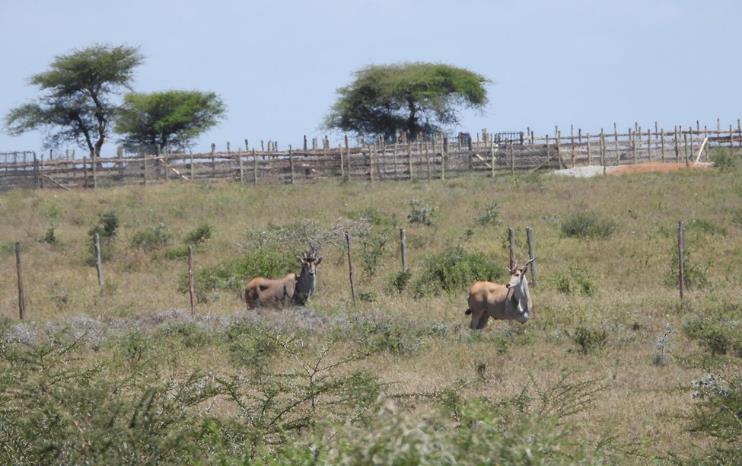
Pic 1: Elands trapped within a fenced property inside Kikesen River Conservancy. Photo: Moses Kisimir.
Murtuna Conservancy: This 6,735-hectare conservancy, located in Matapato South, was established in April 2024. A total of 664 hectares are fenced, with minimal wildlife sightings inside fenced spaces except for a few impalas in one property.
| # | Property owner | GPS Coordinates | Height (meters) | Status | Acreage (ha) | Sighted Wildlife |
|---|---|---|---|---|---|---|
| 1 | Ole Kuntus (closest boma) | -2.422048°S 37.029492°E | 2 | Electric fence (no power) | 113 | No wildlife |
| 2 | Sold by Ole Kidoki (owner unknown) | -2.422048°S 37.029492°E | 2 | electric | 57 | No wildlife |
| 3 | Paul Ruso (KCB CEO) | -2.361117°S 37.043152°E | 2 | Electric | 283 | No wildlife |
| 4 | Robert | -2.362458°S 37.051411°E | 2 | Electric | 57 | Impalas |
| 5 | Martha Koome | -2.362459°S 37.051951°E | 2 | Electric | 57 | No wildlife |
| 6 | Joseph Ole Lenku | -2.421958°S 37.029519°E | 2 | Electric | 97 | No wildlife |
| Total | 664 | |||||
Olgirra Conservancy: Olgirra Conservancy spans approximately 4,781 hectares and emerged from the defunct Mailua group ranches in Matapato South. Only 10 hectares are fenced in the area. No wildlife sightings were reported within the fenced property.
| No | Property owner | GPS Coordinates | Height (meters) | Status | Acreage (ha) | Sighted Wildlife |
|---|---|---|---|---|---|---|
| 1 | Kamau Wachira | -2.358686°S 36.956207°E | 1.5 | Not electric | 10 | No wildlife |
Kaparasi Conservancy: Bordering Oltepesi and Olchorro Oibor Conservancies in Mailua location, Kaparasi Conservancy covers approximately 4,254 hectares. 162 hectares are fenced, with zebras and impalas observed in one property.
| No | Property owner | GPS Coordinates | Height (meters) | Status | Acreage (ha) | Sighted Wildlife |
|---|---|---|---|---|---|---|
| 1 | Wambogo Kariuki | -2.27595°S 36.90654°E | 2 | electric | 162 | Zebras, Impalas |
Noosikitok Conservancy: This conservancy is situated in Mailua location and borders the Namanga-Athi River Highway. Formed from the defunct Mailua group ranches, it was established in March 2021, spanning approximately 8,067 hectares. Intense fencing is threatening the existence of conservation space in this area with a total of 1228 hectares fenced off. The wildlife in the fenced spaces face serious water shortages as well as pasture. A total of 7 giraffes have died in this area since 2023 due to fence entrapment.
| # | Property owner | GPS Coordinates | Height (meters) | Status | Acreage (ha) | Sighted Wildlife |
|---|---|---|---|---|---|---|
| 1 | Wambogo Kariuki | -2.368473°S 36.904904°E | 2 | electric | 202 | Impalas |
| 2 | Titus Naikuni | -2.405542°S 36.870575°E | 2 | Electric | 283 | Giraffes - 3, Impalas |
| 3 | Mr. Osano | -2.394800°S 36.893143°E | 2 | Electric | 53 | No wildlife |
| 4 | Bosire Naftali | -2.357221°S 36.848592°E | 1.5 | Not electric | 4 | No wildlife |
| 5 | John | -2.357221°S 36.848592°E | 1.5 | Not electric | 13 | No wildlife |
| 6 | Ntasikoi Nonkanas | -2.354363°S 36.842503°E | 2 | Not electric | 62 | Zebras, Giraffes - 2 |
| 7 | Ole Narok | -2.350519°S 36.840945°E | 2 | Not electric | 97 | Impalas |
| 8 | PJ DAVE | -2.360233°S 36.843635°E | 2 | Not electric | 57 | Small Mammals |
| 9 | PJ DAVE | -2.365785°S 36.844391°E | 1.5 | Not electric | 97 | Impalas |
| 10 | Sabaya Parmet | -2.393000°S 36.852069°E | 2 | Not electric | 61 | Giraffes - 3 |
| 11 | Partapipi Paul | -2.392720°S 36.852097°E | 2 | Not electric | 299 | Giraffes - 5 |
| Total | 1228 | |||||
Lolbetera Conservancy: Lolbetera is the largest conservancy in the region with a total of 15,579 hectares - 113 hectares are fenced. The conservancy was established in 2021 and there are reports of 23 giraffes killed by electric fences in 2023/24.
| # | Property owner | GPS Coordinates | Height (meters) | Status | Acreage (ha) | Sighted Wildlife |
|---|---|---|---|---|---|---|
| 1 | George Gachara | -2.498308°S 36.942611°E | 2 | Electric | 32 | Reports of 23 giraffes killed by the fence over the last few years |
| 2 | Joseph Mutente | -2.440568°S 36.925957°E | 2 | Not electric | 81 | Giraffes - 7, Killed - 1 |
| Total | 113 | |||||
Oldoinyio Orok Conservancy: Established on 2nd April 2024, Oldoinyio Orok Conservancy spans approximately 12,553 hectares. This conservancy plays a significant role in biodiversity conservation, acting as a habitat for various wildlife species while coexisting with community-led land-use practices.
| # | Property owner | GPS Coordinates | Height (meters) | Status | Acreage (ha) | Sighted Wildlife |
|---|---|---|---|---|---|---|
| 1 | Unknown: Sold by Ntasikoi Nonkanas | -2.348627°S 36.839555°E | 2 | Not electric | 334 | Giraffes (3), Elands, and Zebras |
| 2 | Ole Narok | -2.305574°S 36.821430°E | 2 | Not electric | 81 | Impalas |
| 3 | Wangare | -2.366002°S 36.844363°E | 2 | Not electric | 28 | No wildlife |
| 4 | Nazeel Agha | -2.392618°S 36.850335°E | 2 | Not electric | 24 | Wildlife is managed in the property |
| Total | 467 | |||||
Kikesen River Conservancy: Kikesen River Conservancy lies between hills near the Kenya-Tanzania border, approximately 30 km north of Namanga Town and 34 km west of Bisil Town. Established in August 2020, this community wildlife protection area spans 11,224 hectares, initiated by 100 Maasai landowners. Of 11,224 hectares, the conservancy has one 121-hectare fenced property that has entrapped giraffes, impalas, female ostriches, and elands.
Several months prior to the assessment, community scouts reported the presence of a solitary giraffe within the confines of this property. During the subsequent assessment, the team identified additional species that had entered the fenced area but were unable to exit.
| # | Property owner | GPS Coordinates | Height (meters) | Status | Acreage (ha) | Sighted Wildlife |
|---|---|---|---|---|---|---|
| 1 | Ntasikoi Nonkanas | -2.276943°S 36.583419°E | 2 | Not electric | 121 | Giraffe - 1, Impalas - 7, Ostrich - 3, Elands - 2 |
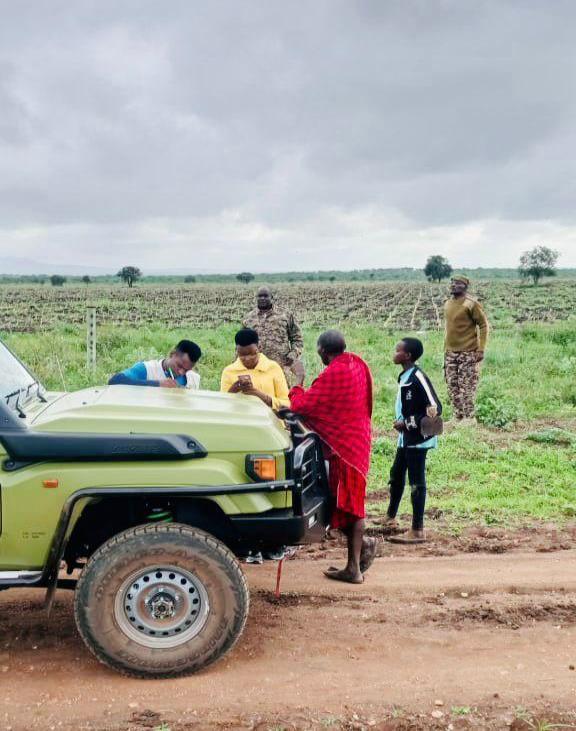
Pic 3: Data collection at Oltepesi and Olchorro Oibor conservancies
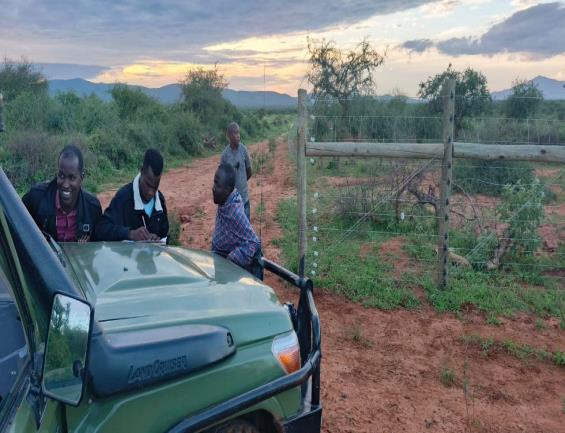
Pic 3/4: Assessment of fenced properties in Kaparasi Conservancy
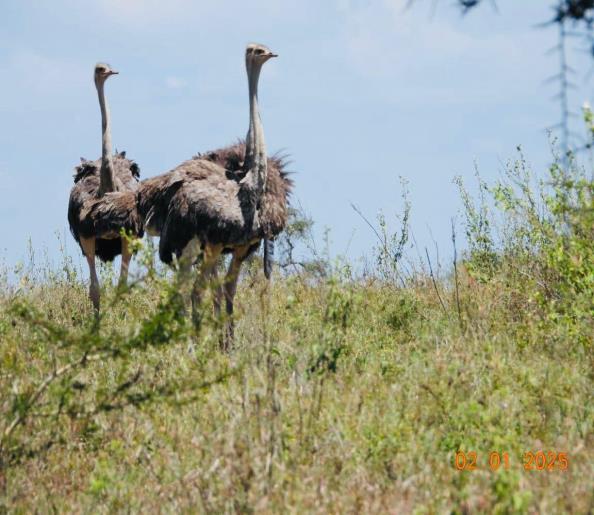
Pic 5/6: Wildlife sighted in a fenced property at Kikesen River Conservancy
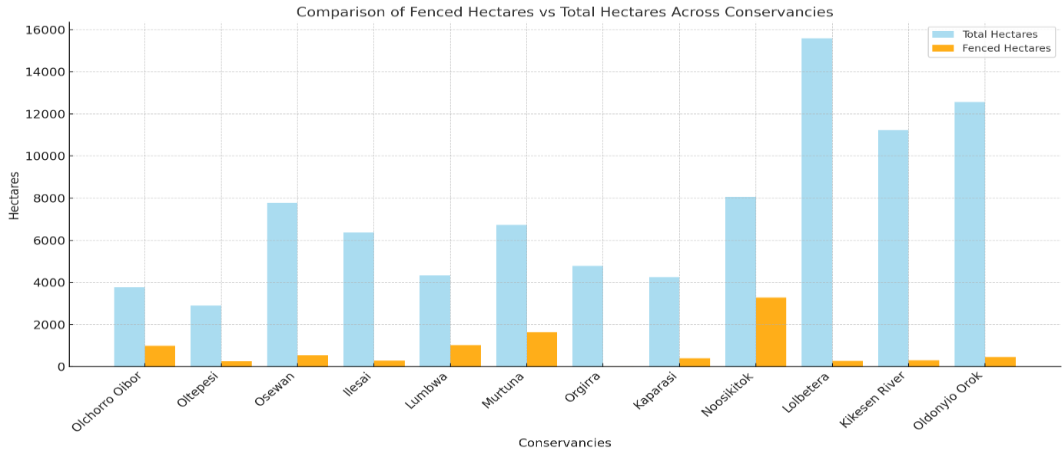
This bar graph compares the fenced spaces and total acreage across all the assessed conservancies. It illustrates the proportion of land within each conservancy that is fenced versus the total land area.
The assessment of fenced properties in Matapato North and South Wards has revealed critical challenges that threaten both wildlife and the ecological integrity of the region. The alarming statistics of wildlife entrapment, particularly the significant loss of giraffes and other species, underscore the urgent need for immediate and effective intervention. As we move forward, it is imperative to prioritize the restoration of migratory corridors and the re-establishment of ecological balance within these conservancies.
To achieve this, collaborative efforts between local communities, conservation organizations, and government authorities are essential. By fostering community engagement and awareness regarding the ecological impacts of fencing, we can cultivate a shared responsibility towards wildlife conservation.
Implementing regulatory measures that promote wildlife-friendly land-use practices will not only safeguard biodiversity but also enhance the sustainability of local livelihoods.
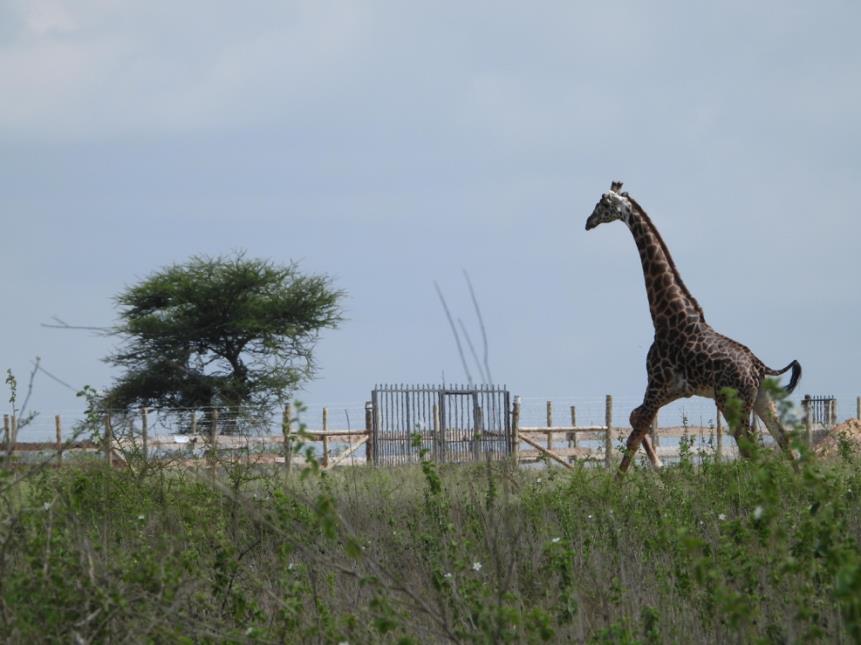
A famous giraffe inside a fenced property in Kikesen River Conservancy. Photo: Moses Kisimir
The recommendations outlined in this report serve as a roadmap for addressing these pressing issues. Facilitating wildlife rescue operations, enforcing planning regulations, and encouraging alternative land-use practices are critical steps that must be taken without delay. With timely action and continued collaboration, we can mitigate the adverse effects of fencing and ensure a harmonious coexistence between wildlife and human activities in Central Kajiado. The future of this unique ecosystem depends on our collective commitment to preserving its rich biodiversity for generations to come.
We extend our sincere appreciation to Mr. Francis Mbaka, KWS Kajiado County Warden, and Mr. Joel Nyika, County Director for Tourism and Wildlife, for their invaluable guidance and unwavering dedication throughout this process.
Our gratitude also goes to Fiona Sanderman, Director of East Africa at Save Giraffes Now, for her swift response in mobilizing resources to support this urgent assessment.
Lastly, we recognize the dedicated teams from Kenya Wildlife Service (Kajiado) and RAMAT Wildlife Society who conducted the rapid assessment. Their commitment, expertise, and tireless efforts were instrumental in carrying out this crucial work:
Ramat Wildlife Society, Neighbours Initiative Alliance Building, Off Namanga Highway, Kajiado Town.
Tel: 254791197454
Email: [email protected]
Visit: www.ramatwildlife.org